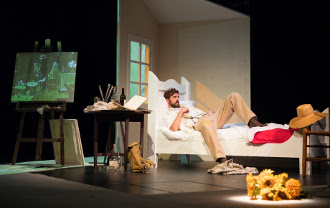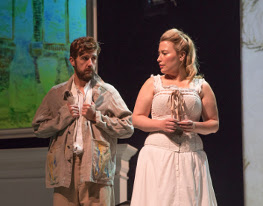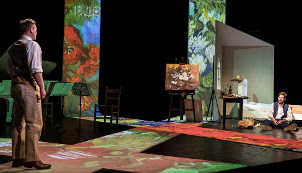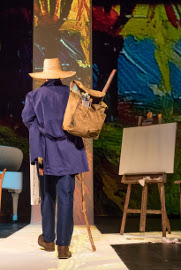
Glenda Frank
| "Van
Gogh's Ear."
"Van Gogh's Ear." Produced by Ensemble for the
Romantic Century.
Sometimes even familiar words or phrases provide a challenge. Is it envelop (n) or envelop (v)? Refuse (n) or refuse (v)? So when I read the title "Van Gogh's Ear," I read "Van Gogh" and trotted down to Pershing Square Signature Center with dramatic and painterly expectations. Instead "ear" was the word the production prioritized.
The dramatic frame is Van Gogh's last years: the loneliness and self-mutilation, the institutionalizations, his brother's support, and Vincent's suicide. But the work is mostly a 100 minute chamber recital with intermission The admirable musicians play about a dozen selections by Claude DeBussy, Gabriel Fauré, Ernest Chausson, and César Franck. Most pieces are instrumental but a few are sung by Renée Tatum -- as a model and as Vincent's sister-in-law -- and Chad Johnson, as Vincent's brother. A stiff Carter Hudson, from FX's "Snowfall," played the artist; Kevin Spirtas plays two supporting roles. Did Vincent ever hear this music performed? Probably not. The connection is that all lived during the 19th century, the Romantic Century. Perhaps ERC was also thinking about novelist Herman Melville's theory that if all geniuses, despite time and place, were to link hands there would be a "shock of recognition." Can we see in Van Gogh what we hear in Debussy?
The music is loosely – very loosely – linked to events in the painter's life. When he wrote about longing for a wife, Tatum sings about a woman's unrequited love. Sometimes analogies are helpful, but the audience must first adapt to the synesthesia of the work (the confusion of senses) so that painting becomes music and music is drama – while reading the supertitles that translate the songs into English. Meanwhile Carter, with a skimpy script, has to discover stage business that matches both the music and Van Gogh's life at the moment. His competition is not only the music but also the wonderful projections of the paintings (David Bengali), both as full pieces on the backdrop and as magnified brushstrokes on the floor. I tried to let it all wash over me – engulf me in the experience. I was most successful when the music – performed by two violinist, a viola and a cello player, and two pianists – was only instrumental.
The second act is stronger than the first, probably because we have more characters and more locations. One segment stands out, the Gabriel Fauré Piano Quintet no. 2 in C minor, near the end, when the artist's struggle and music seems of a piece. And then, of course, the Claude Debussy Beau Soir (transcribed for cello and piano) is a strong final comment. The Ensemble for the Romantic Century with present "Mary Shelley's Frankenstein" from December 21 - January 7th, 2018, at The Pershing Square Signature Center. ERC calls the work parallel narratives. It will include Bach-inspired music of the 19th century, from Liszt and Schubert.
|
| museums | NYTW mail | recordings | coupons | publications | classified |




